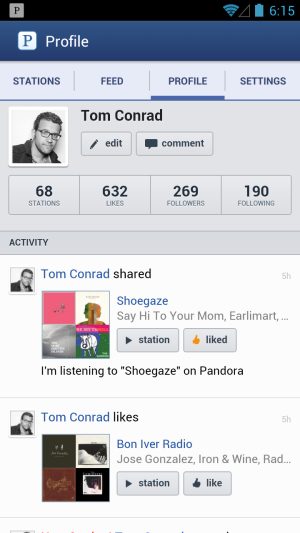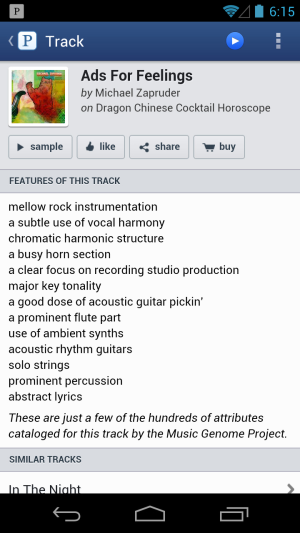
Here comes Pandora 4.0, a big remake of the music service's mobile listening environment. If you are a Pandora fan, get ready for expanded playlist, station-making, lyric-reading, personal profile, and social networking power on your smartphone. The new service creates a "unifying" experience across web and mobile devices, the company proclaims. It also represents about six or seven years of planning, thinking, and development for the outfit.
Back in 2005, iPhone and Android mobile gadgets were gleams in the eye of Apple and Google. Pandora, however, was transforming radio and music distribution with its sophisticated "genome" powered song recommendation algorithm. Millions of users were clicking thumbs up or down to millions of tunes on, well, millions of Pandora channels. By 2007, Pandora was a huge hit.
It was, however, mostly a desktop computer hit. "We started thinking about creating a mobile service in 2004," Pandora CTO Tom Conrad told us in an interview. "We wanted to unify the Pandora experience." That meant an experience that was easy from the start, that allowed users to individualize their environment and get more of what they wanted, and that was "ubiquitously available."
"But the technical environment of 2005 did not let us do the ubiquity thing," Conrad explained. Then came the Apple App Store in 2008, and Pandora found itself one of the top five most downloaded mobile applications. Over the next four years 75 percent of Pandora listening shifted to smartphones. The company says that over 115 million registered users have tuned into the service on a smart mobile. The platform represents around 55 percent of its advertising revenue.

All this has put more and more pressure on the company to rewrite its mobile interface. Up until now, the mobile experience "has functionally been catching up to the web," Conrad observed.
That was then, Pandora hopes. Here's what Android and iPhone Pandora lovers will get now (and Windows Phone 8 users will get in early 2013).
Curators and mentors
The new Pandora mobile experience starts with an elaborate profile page that chronicles your activity, your stations, your likes, users you are following, and your fans. Users can make it public or private or share it on Facebook and Twitter. It will narrate the channels you created, the songs you shared, the tunes you liked, and allow you to follow the activities of your friends.
"We are trying to create an environment in which you can be very selective about who you want to follow," Conrad told us, giving users the option of collaborating with other users as mentors or music curators.
Pandora 4.0 will also offer mobile subscribers more access to music information: song lyrics, artist profiles, and even lists of Genome attributes. The screenshot below, for example, exhibits Genome qualities for "Ads for Feelings" by Michael Zapruder. These include "a busy horn section" and "a prominent flute part." Bottom line: the mobile user gets clued into how the track became part of her queue. Channel making and channel shuffling capacities have been expanded. And the search software has been improved.

"Searches are smarter now," Conrad explained. "'Pop' will get you today's hits; 'Adele' will get you Adele."
Rivals and rates
Pandora 4.0 for iOS smartphones goes live for download in the App Store at 5 pm EDT on Monday, 29 October. The Android version is going to take a little longer to show up in Google Play—"in the coming weeks," we were told. The upgrades arrive as the smartphone radio field is diversifying and expanding. Pandora still has a huge profile, but is hardly the only kid on the block. Spotify, Rdio, Last.fm, Turntable.fm all have big followings in the United States. Even Apple has been making noises about setting up a Pandora rival for the iPhone and iPad.
I asked Conrad about the Apple possibility. He didn't dismiss the prospect as insignificant, but he didn't seem too worried, either.
"When we launched in 2005, AOL and Microsoft were the largest services; MySpace was the gorilla in the room," Conrad noted. "Clear Channel was getting serious about iHeartRadio. What has allowed us to succeed despite stiff competition is that we are dedicated to the future of radio. We have a simple, elegant product to which we are devoted, and which we think we can produce better than anybody else."
Aside from its scale, Pandora also stands out because of its high-profile advocacy of Internet performance royalty reform. Pandora founder Tim Westergren is outspoken in his support of the Internet Radio Fairness Act, now making its way through the House and Senate. Pandora says about half of its revenues go to performance royalties. The proposed legislation in both its Senate and House forms would put rates on a par with those paid by satellite and cable-based radio services.

Pandora listeners are likely to support the initiative without too much cajoling. The big challenge will be getting artists and musicians to at least sympathize with the idea.
In a recent blog post, Westergren disclosed the rates paid to various artists featured on the service. Two thousand will receive over $10,000 each over the next 12 months. "And for more than 800 we'll pay over $50,000, more than the income of the average American household," he added. But these payouts come at the expense of Pandora's expansion.
"Making performance fees fair for internet radio will drive massive investment in the space, accelerating the growth of the overall sector," Westergren concluded. "The short-term reduction in revenue would be rapidly swamped by the overall growth of the sector. Imagine the impact on artists if this industry grew to become 25 percent or even 50 percent of radio listening."
Trying to get musicians to sympathize with lower royalties is going to be a tough sell. The new expanded artist profiles on Pandora 4.0 might help generate some good will. Then again, count on plenty of opposition from the labels, and from performance royalty distributor SoundExchange.
"It's our hope that Internet radio platforms like Pandora continue to thrive," the non-profit declared in a response statement. "But the company can't cut costs at the expense of musicians. It's simply unfair."
reader comments
40